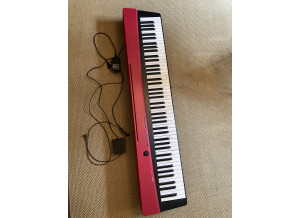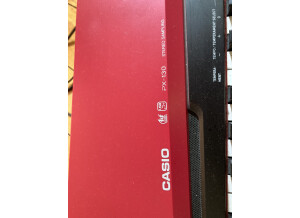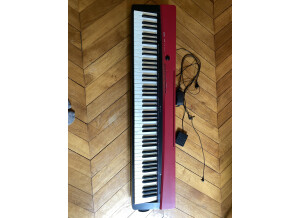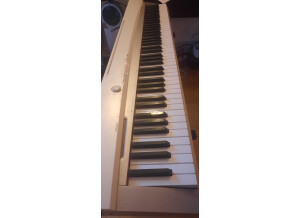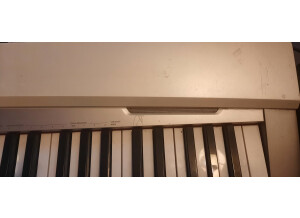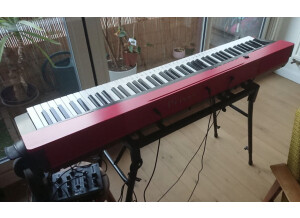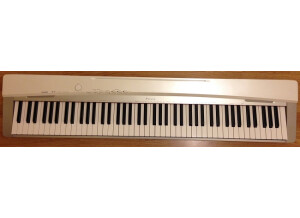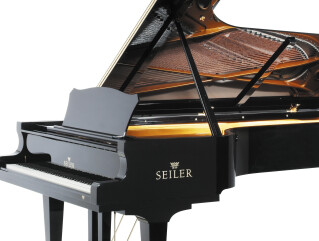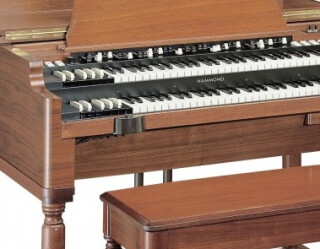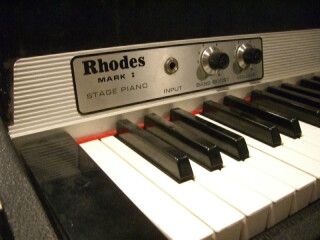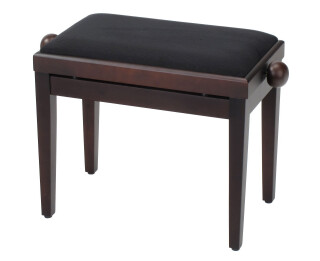Annonces Privia PX-130
Alerte nouvelle annonceForums Casio Privia PX-130
Images
Avis
4.8/5(4 avis)
75 %
25 %
Donner un avis
Excellent toucher
Publié le 31/01/13 à 01:3588 touches avec 3 sons principaux, les autres sont disponible par combinaison de touches. Possibilités de réglages diverses. Métronome intégré.Double sortie casque. Fourni avec alim et "pédale" de sustain.
UTILISATION
J'ai acheté ce clavier pour reprendre le piano après presque 10ans sans jouer. Ne sachant pas si la reprise allait être facile, je n'ai pas voulu trop investir. Le seul point important était le toucher type lourd. Je ne suis pas déçu, c'est exactement ce que je cherchais.
La configuration est aisée, c'est Plug and Play. Seuls 2-3 points de configurations nécessitent le manuel, rien de sorcier en tout cas.
Je rajouterai juste que j'ai changé la pédale de sustain pour un...…
UTILISATION
J'ai acheté ce clavier pour reprendre le piano après presque 10ans sans jouer. Ne sachant pas si la reprise allait être facile, je n'ai pas voulu trop investir. Le seul point important était le toucher type lourd. Je ne suis pas déçu, c'est exactement ce que je cherchais.
La configuration est aisée, c'est Plug and Play. Seuls 2-3 points de configurations nécessitent le manuel, rien de sorcier en tout cas.
Je rajouterai juste que j'ai changé la pédale de sustain pour un...…
Lire la suite
88 touches avec 3 sons principaux, les autres sont disponible par combinaison de touches. Possibilités de réglages diverses. Métronome intégré.Double sortie casque. Fourni avec alim et "pédale" de sustain.
UTILISATION
J'ai acheté ce clavier pour reprendre le piano après presque 10ans sans jouer. Ne sachant pas si la reprise allait être facile, je n'ai pas voulu trop investir. Le seul point important était le toucher type lourd. Je ne suis pas déçu, c'est exactement ce que je cherchais.
La configuration est aisée, c'est Plug and Play. Seuls 2-3 points de configurations nécessitent le manuel, rien de sorcier en tout cas.
Je rajouterai juste que j'ai changé la pédale de sustain pour un modèle M-Audio qui est a 100 lieues du bout de plastique fourni par Casio... L'autre solution consiste à acheter le clavier avec le stand et le pédalier.
07-08-2014: J'ai depuis acheté le stand et le pédalier correspondant et c'est beaucoup plus agréable comme hauteur comparé a un stand classique. De plus, c'est encore plus joli
SONORITÉS
La puissance sonore est satisfaisante en appartement. La qualité des haut-parleurs laisse a désirer, je ne sais pas si le fait de brancher des moniteurs peut améliorer le rendu (sûrement). En tout cas, avec un bon casque c'est plutôt convainquant.
Je n'utilise que les sons piano classique et moderne avec parfois un peu de reverb sur le moderne.
Le toucher est excellent (encore une fois). La vélocité est réglable même si je ne voit pas l’intérêt (a quoi bon acheter un clavier avec toucher piano!). Je la règle au maximum. Cependant même avec ce réglage, les pianissimo sont délicats a obtenir.
AVIS GLOBAL
Je l'utilise depuis un an maintenant.
Les plus :
- les 88 touches
- le toucher piano
Les moins:
- Sonorité
- Pédale sustain fournie
Comparé a des Yamaha et autrse casio en magasin, celui-ci m'a le plus convaincu du point de vue du toucher et du prix.
Acheté 499 dollars chez Guitar Center, soit environ 370 Euros, c'est une excellente affaire!
UTILISATION
J'ai acheté ce clavier pour reprendre le piano après presque 10ans sans jouer. Ne sachant pas si la reprise allait être facile, je n'ai pas voulu trop investir. Le seul point important était le toucher type lourd. Je ne suis pas déçu, c'est exactement ce que je cherchais.
La configuration est aisée, c'est Plug and Play. Seuls 2-3 points de configurations nécessitent le manuel, rien de sorcier en tout cas.
Je rajouterai juste que j'ai changé la pédale de sustain pour un modèle M-Audio qui est a 100 lieues du bout de plastique fourni par Casio... L'autre solution consiste à acheter le clavier avec le stand et le pédalier.
07-08-2014: J'ai depuis acheté le stand et le pédalier correspondant et c'est beaucoup plus agréable comme hauteur comparé a un stand classique. De plus, c'est encore plus joli
SONORITÉS
La puissance sonore est satisfaisante en appartement. La qualité des haut-parleurs laisse a désirer, je ne sais pas si le fait de brancher des moniteurs peut améliorer le rendu (sûrement). En tout cas, avec un bon casque c'est plutôt convainquant.
Je n'utilise que les sons piano classique et moderne avec parfois un peu de reverb sur le moderne.
Le toucher est excellent (encore une fois). La vélocité est réglable même si je ne voit pas l’intérêt (a quoi bon acheter un clavier avec toucher piano!). Je la règle au maximum. Cependant même avec ce réglage, les pianissimo sont délicats a obtenir.
AVIS GLOBAL
Je l'utilise depuis un an maintenant.
Les plus :
- les 88 touches
- le toucher piano
Les moins:
- Sonorité
- Pédale sustain fournie
Comparé a des Yamaha et autrse casio en magasin, celui-ci m'a le plus convaincu du point de vue du toucher et du prix.
Acheté 499 dollars chez Guitar Center, soit environ 370 Euros, c'est une excellente affaire!
Lire moins
10
»
Je l'adore !
Publié le 17/11/11 à 21:05Combien d'octaves ?
88 Touches
Quelle connectique (Audio, MIDI, pédales...) ? ...
2 prises casques (petit jack)
1 prise USB
1 pédale sustain incluse
1 alimentation externe incluse
Combien de sons, d'effets disponibles ? Sont-ils éditables ?
16 sons : 2 pianos. Je n'ai pas trop poussé je viens de l'avoir.
UTILISATION
Le toucher du clavier est-il agréable ? Convient-il à votre utilisation ?
Auparavant je jouais sur un clavier maitre midi M-Audio Keystation 88es, et si on peut comparer mon ancien clavier à une clio , celui ci est une bentley !! C'est la première fois que j'ai un clavier avec le toucher lourd et c'est vraiment très agréable. Apparemment ils ont étudié le...…
88 Touches
Quelle connectique (Audio, MIDI, pédales...) ? ...
2 prises casques (petit jack)
1 prise USB
1 pédale sustain incluse
1 alimentation externe incluse
Combien de sons, d'effets disponibles ? Sont-ils éditables ?
16 sons : 2 pianos. Je n'ai pas trop poussé je viens de l'avoir.
UTILISATION
Le toucher du clavier est-il agréable ? Convient-il à votre utilisation ?
Auparavant je jouais sur un clavier maitre midi M-Audio Keystation 88es, et si on peut comparer mon ancien clavier à une clio , celui ci est une bentley !! C'est la première fois que j'ai un clavier avec le toucher lourd et c'est vraiment très agréable. Apparemment ils ont étudié le...…
Lire la suite
Combien d'octaves ?
88 Touches
Quelle connectique (Audio, MIDI, pédales...) ? ...
2 prises casques (petit jack)
1 prise USB
1 pédale sustain incluse
1 alimentation externe incluse
Combien de sons, d'effets disponibles ? Sont-ils éditables ?
16 sons : 2 pianos. Je n'ai pas trop poussé je viens de l'avoir.
UTILISATION
Le toucher du clavier est-il agréable ? Convient-il à votre utilisation ?
Auparavant je jouais sur un clavier maitre midi M-Audio Keystation 88es, et si on peut comparer mon ancien clavier à une clio , celui ci est une bentley !! C'est la première fois que j'ai un clavier avec le toucher lourd et c'est vraiment très agréable. Apparemment ils ont étudié le mécanisme du marteau à fond pour ce type de piano et bien qu'il ne coute pas 1300 euros, c'est le même clavier que pour les modèles haut de gamme privia. Il y a un tout petit jeu latéral dans les touches comme pour un vrai piano. J'ai joué sur le piano numérique Roland de mon patron ce midi et je trouve le touché du casio plus dur.
Le manuel est-il clair et suffisant ? ...
Depuis le temps que je l'attendais je n'ai pas lu le manuel mais il est énorme et les partitions des démos (chopin, mozart...) sont livrées avec.
La configuration générale est-elle simple ?
La sélection des canaux MIDI, des patchs est-elle facile ?
Du fait qu'il n'y ait pas d'écran LCD la configuration n'est pas simple, il n'y a que 6 boutons et pour configurer les effets etc il faut faire des combinaisons entre ces boutons et les touches du piano. En même temps c'est un piano numérique pas une workstation Motif XS8 (snif.... c'était mon rêve)
La sélection des canaux MIDI, des patchs est-elle facile ?
Tout ça c'est du chinois pour moi. J'appuie sur power et c'est parti !
SONORITÉS
Les sons conviennent-ils à votre style de musique ?
Je ne suis surement pas le meilleur juge à ce sujet, mais je trouve les sons corrects et au pire si un jour ils me lassent, je le connecte en USB sur mon PC pour lui faire jouer des instruments virtuels.
Sont-ils réalistes ?
Quelles sont les sonorités que vous préférez, que vous détestez ? ...
Les pianos acoustiques et les orgues électriques sont pour moi, très bons.
L'expression est-elle bonne ? (réaction à la vélocité, à l'aftertouch) ?
Sans aucune comparaison avec mon ancien clavier.
AVIS GLOBAL
Depuis combien de temps l'utilisez vous ?
2 Jours
Aviez vous essayé beaucoup d'autres modèles avant de l'acquérir ?
Je ne l'ai même pas essayé lui donc non.
Quelle est la particularité que vous aimez le plus, le moins ?
Les +.
Qualité du toucher, je ne le trouve pas trop moche aussi , le blanc pour ma part je l'ai pris sans son stand et ça lui donne une allure très moderne les sons qui me conviennent très bien, et j'en ai testé pas mal avec mon ancien clavier maitre.
les sons qui me conviennent très bien, et j'en ai testé pas mal avec mon ancien clavier maitre.
Les -.
Ergonomie pour appliquer des effets ou accéder aux différents sons via des combinaisons de touches. 3 sons de base (Piano modern, piano classique, piano elec) sont toutefois directement accessibles.
Les enceintes ne tiennent pas la route.
Au sujet des moins, je n'ai clairement pas acheté le piano pour ces points, puisqu'au niveau de la qualité du son j'ai juste à le brancher sur des enceintes ou au casque. Pour l'ergonomie c'est quand même une goutte d'eau comparé à la qualité du toucher.
Comment jugez vous le rapport qualité/prix ?
Avec l'expérience, referiez vous ce choix ? ...
Je l'ai payé 429 euros tout compris avec un DVD de 630 partitions. Je pense qu'au niveau rapport qualité prix, il n'y a pas mieux pour un clavier 88 notes toucher lourd avec de vrais marteaux dedans.
88 Touches
Quelle connectique (Audio, MIDI, pédales...) ? ...
2 prises casques (petit jack)
1 prise USB
1 pédale sustain incluse
1 alimentation externe incluse
Combien de sons, d'effets disponibles ? Sont-ils éditables ?
16 sons : 2 pianos. Je n'ai pas trop poussé je viens de l'avoir.
UTILISATION
Le toucher du clavier est-il agréable ? Convient-il à votre utilisation ?
Auparavant je jouais sur un clavier maitre midi M-Audio Keystation 88es, et si on peut comparer mon ancien clavier à une clio , celui ci est une bentley !! C'est la première fois que j'ai un clavier avec le toucher lourd et c'est vraiment très agréable. Apparemment ils ont étudié le mécanisme du marteau à fond pour ce type de piano et bien qu'il ne coute pas 1300 euros, c'est le même clavier que pour les modèles haut de gamme privia. Il y a un tout petit jeu latéral dans les touches comme pour un vrai piano. J'ai joué sur le piano numérique Roland de mon patron ce midi et je trouve le touché du casio plus dur.
Le manuel est-il clair et suffisant ? ...
Depuis le temps que je l'attendais je n'ai pas lu le manuel mais il est énorme et les partitions des démos (chopin, mozart...) sont livrées avec.
La configuration générale est-elle simple ?
La sélection des canaux MIDI, des patchs est-elle facile ?
Du fait qu'il n'y ait pas d'écran LCD la configuration n'est pas simple, il n'y a que 6 boutons et pour configurer les effets etc il faut faire des combinaisons entre ces boutons et les touches du piano. En même temps c'est un piano numérique pas une workstation Motif XS8 (snif.... c'était mon rêve)
La sélection des canaux MIDI, des patchs est-elle facile ?
Tout ça c'est du chinois pour moi. J'appuie sur power et c'est parti !
SONORITÉS
Les sons conviennent-ils à votre style de musique ?
Je ne suis surement pas le meilleur juge à ce sujet, mais je trouve les sons corrects et au pire si un jour ils me lassent, je le connecte en USB sur mon PC pour lui faire jouer des instruments virtuels.
Sont-ils réalistes ?
Quelles sont les sonorités que vous préférez, que vous détestez ? ...
Les pianos acoustiques et les orgues électriques sont pour moi, très bons.
L'expression est-elle bonne ? (réaction à la vélocité, à l'aftertouch) ?
Sans aucune comparaison avec mon ancien clavier.
AVIS GLOBAL
Depuis combien de temps l'utilisez vous ?
2 Jours
Aviez vous essayé beaucoup d'autres modèles avant de l'acquérir ?
Je ne l'ai même pas essayé lui donc non.
Quelle est la particularité que vous aimez le plus, le moins ?
Les +.
Qualité du toucher, je ne le trouve pas trop moche aussi , le blanc pour ma part je l'ai pris sans son stand et ça lui donne une allure très moderne
Les -.
Ergonomie pour appliquer des effets ou accéder aux différents sons via des combinaisons de touches. 3 sons de base (Piano modern, piano classique, piano elec) sont toutefois directement accessibles.
Les enceintes ne tiennent pas la route.
Au sujet des moins, je n'ai clairement pas acheté le piano pour ces points, puisqu'au niveau de la qualité du son j'ai juste à le brancher sur des enceintes ou au casque. Pour l'ergonomie c'est quand même une goutte d'eau comparé à la qualité du toucher.
Comment jugez vous le rapport qualité/prix ?
Avec l'expérience, referiez vous ce choix ? ...
Je l'ai payé 429 euros tout compris avec un DVD de 630 partitions. Je pense qu'au niveau rapport qualité prix, il n'y a pas mieux pour un clavier 88 notes toucher lourd avec de vrais marteaux dedans.
Lire moins
20
»
Sentez-vous exceptionnel pour les bas prix
Publié le 06/12/11 à 21:21This keyboard has the full 88 keybed. The only connections on this unit are 1/4" headphone outputs, USB and a sustain jack. One big complaint by people is that it does not have a dedicated Line output. It does however have built in speakers. The PX 130 only has Grand Piano and Electric Piano sounds. And the only effect was a reverb selector. Both sounds and effects cannot be edited.
UTILIZATION
This is as simple as it gets in terms of setup and use from a digital instrument. Simply plug it in to your wall, turn it on, and play. Some may argue that the lack of sounds and effects is a bad thing but I bought this unit for practice purposed only and I love its simplicity. I have never needed to look at the manual and I do not intend to as this can be figured out in minutes, maybe even seconds. There are only a few buttons to select which piano patch you want (two acoustics, one electric).
SOUNDS
Coming out of the built in speakers, the sounds are not really that realistic. Coming out of a nicer PA or set up bookshelf speakers, they are quite better. Overall, I didn't but this unit for its sound quality. That's why you need to spend $2000 or more for a nice Nord. This piano was bought because it was inexpensive and it has excellent feel and expressiveness. I was truly surprised to feel such a nice keybed at a piano found in stores like Best Buy. So much that I bought one. I won't argue that this is a replacement for a real piano, but if you are like me and don't own your home, but want to be able to practice on a nice instrument and keep up your chops when you are away from your main rig, then this is perfect for you. It weighs under 30 lbs. for easy travel too.
OVERALL OPINION
What I like most about this unit is the feel of the action. Although not exactly like a real piano, it offers surprisingly convincing feel for under $500. In fact, it is far better than the Korg TR I sold awhile back, and that cost over $2000 brand new. I can't say that I personally dislike anything about it. The samples are not great but they certainly do the job in terms of practice and the unit is quite expressive. This is my first Casio weighted keyboard and I have to say, I'm a fan. Yes, I would definitely buy this again. I recommend it to all my friends who want there kids to start the piano but don't want to deal with all the work of a real piano.
UTILIZATION
This is as simple as it gets in terms of setup and use from a digital instrument. Simply plug it in to your wall, turn it on, and play. Some may argue that the lack of sounds and effects is a bad thing but I bought this unit for practice purposed only and I love its simplicity. I have never needed to look at the manual and I do not intend to as this can be figured out in minutes, maybe even seconds. There are only a few buttons to select which piano patch you want (two acoustics, one electric).
SOUNDS
Coming out of the built in speakers, the sounds are not really that realistic. Coming out of a nicer PA or set up bookshelf speakers, they are quite better. Overall, I didn't but this unit for its sound quality. That's why you need to spend $2000 or more for a nice Nord. This piano was bought because it was inexpensive and it has excellent feel and expressiveness. I was truly surprised to feel such a nice keybed at a piano found in stores like Best Buy. So much that I bought one. I won't argue that this is a replacement for a real piano, but if you are like me and don't own your home, but want to be able to practice on a nice instrument and keep up your chops when you are away from your main rig, then this is perfect for you. It weighs under 30 lbs. for easy travel too.
OVERALL OPINION
What I like most about this unit is the feel of the action. Although not exactly like a real piano, it offers surprisingly convincing feel for under $500. In fact, it is far better than the Korg TR I sold awhile back, and that cost over $2000 brand new. I can't say that I personally dislike anything about it. The samples are not great but they certainly do the job in terms of practice and the unit is quite expressive. This is my first Casio weighted keyboard and I have to say, I'm a fan. Yes, I would definitely buy this again. I recommend it to all my friends who want there kids to start the piano but don't want to deal with all the work of a real piano.
00
»
La meilleure façon d'obtenir en 88 touches digitales
Publié le 26/06/11 à 10:41This generation of Casio digital pianos has made me a huge proponent of them, over even the popularly preferred Yamaha pianos and certainly over the Korgs. I own the PX-330, but when in Thailand, with nothing to do but shop for pianos, I kept on gravitating towards the PX-130 over its competitors time and time again.
First off, it's nice to know that there are two headphone jacks, so two people can listen or play without disturbing anyone. Next, it does include USB MIDI connectivity to the computer, so it can be used as a MIDI controller. It is an entry level piano, and as such lacks pitch bends and mod wheels. However, considering its older brother, the PX-330 fitting where it fits (see my review of the PX-330) the PX-130 fills a very nice niche: people who just want to play piano! The PX-130 features 16 sounds, but the piano sounds are the only ones that really matter anyway, so that's what I'll be reviewing!
UTILIZATION
I think this is one of the most simple to use keyboards on the market. The main features, like the pianos, are accessible with their own dedicated buttons. However, several functions are located on the keybed. You just pair the function key with the labeled key, and BAM! Instant gratification. The nice thing about this keyboard is that it makes it easy to do these things, without overwhelming the user with these functions. Despite the fact that its older brother, the PX-330 (which I own), has more dedicated controls, the single-layered simplicity of the 130 definitely makes it much more workable than the 330 I own.
The fact that they are labeled also gives it a distinct advantage over the Korg SP170. The SP170 is a very appealing machine aesthetically, but it cannot compare with the Casio's usability in any way at all.
SOUNDS
Since this is a very basic piano, Casio just jammed the 16 cream-of-the-crop-every-piano-needs-these-sounds sounds into it. That means that unlike my PX-330 and its largely inspirational, but sometimes pathetic and superfluous sounds, pretty much every sound on the PX-130 is usable, although quite corny at times. (I'm looking at you, organs.) The best ones are obviously the pianos, but the first E.piano and the strings are also quite good. There's really nothing else to say about the sound, except that the reverb and brilliance are also adjustable via the function key.
The touch and feel of the PX-130 is excellent. Despite Yamaha's reputation for holding that throne, I find that because Yamaha makes acoustic pianos, their digital pianos strive to emulate the keybeds of their acoustics. Personally (it may be different for all of you), I find the Yamaha pianos to have very abrupt action. Crisp, but very grating at times. The PX-130 has just that right level of sponginess. Growing up on a Steinway baby grand, I appreciate lightness, but the Yamaha's in my opinion take it a bit too far.
I also want to mention that the PX-130 has a standard 128-note polyphony. The Yamaha P95, which costs more, has only 64. This difference can be crippling when playing thick passages or when layering different instruments.
OVERALL OPINION
The PX-130 is a great way to get into the world of digital pianos. It offers a no-frills experience to those who just want to play, and a simple and intuitive interface for those who want to tweak just a little bit. If you're the more adventurous type, check out the PX-330, which for all intents and purposes, is the same piano with more buttons and sounds and a better stage-piano flair.
I still encourage you to try the other brands, as pianos are quite subjective. In this generation, the Casio line dominates the sub $1k market for me. However, it is up to you to decide.
First off, it's nice to know that there are two headphone jacks, so two people can listen or play without disturbing anyone. Next, it does include USB MIDI connectivity to the computer, so it can be used as a MIDI controller. It is an entry level piano, and as such lacks pitch bends and mod wheels. However, considering its older brother, the PX-330 fitting where it fits (see my review of the PX-330) the PX-130 fills a very nice niche: people who just want to play piano! The PX-130 features 16 sounds, but the piano sounds are the only ones that really matter anyway, so that's what I'll be reviewing!
UTILIZATION
I think this is one of the most simple to use keyboards on the market. The main features, like the pianos, are accessible with their own dedicated buttons. However, several functions are located on the keybed. You just pair the function key with the labeled key, and BAM! Instant gratification. The nice thing about this keyboard is that it makes it easy to do these things, without overwhelming the user with these functions. Despite the fact that its older brother, the PX-330 (which I own), has more dedicated controls, the single-layered simplicity of the 130 definitely makes it much more workable than the 330 I own.
The fact that they are labeled also gives it a distinct advantage over the Korg SP170. The SP170 is a very appealing machine aesthetically, but it cannot compare with the Casio's usability in any way at all.
SOUNDS
Since this is a very basic piano, Casio just jammed the 16 cream-of-the-crop-every-piano-needs-these-sounds sounds into it. That means that unlike my PX-330 and its largely inspirational, but sometimes pathetic and superfluous sounds, pretty much every sound on the PX-130 is usable, although quite corny at times. (I'm looking at you, organs.) The best ones are obviously the pianos, but the first E.piano and the strings are also quite good. There's really nothing else to say about the sound, except that the reverb and brilliance are also adjustable via the function key.
The touch and feel of the PX-130 is excellent. Despite Yamaha's reputation for holding that throne, I find that because Yamaha makes acoustic pianos, their digital pianos strive to emulate the keybeds of their acoustics. Personally (it may be different for all of you), I find the Yamaha pianos to have very abrupt action. Crisp, but very grating at times. The PX-130 has just that right level of sponginess. Growing up on a Steinway baby grand, I appreciate lightness, but the Yamaha's in my opinion take it a bit too far.
I also want to mention that the PX-130 has a standard 128-note polyphony. The Yamaha P95, which costs more, has only 64. This difference can be crippling when playing thick passages or when layering different instruments.
OVERALL OPINION
The PX-130 is a great way to get into the world of digital pianos. It offers a no-frills experience to those who just want to play, and a simple and intuitive interface for those who want to tweak just a little bit. If you're the more adventurous type, check out the PX-330, which for all intents and purposes, is the same piano with more buttons and sounds and a better stage-piano flair.
I still encourage you to try the other brands, as pianos are quite subjective. In this generation, the Casio line dominates the sub $1k market for me. However, it is up to you to decide.
10
»
Fiche technique
- Fabricant : Casio
- Modèle : Privia PX-130
- Série : Privia
- Catégorie : Pianos numériques
- Fiche créée le : 28/02/2010
Nous n'avons pas de fiche technique sur ce produit
mais votre aide est la bienvenue
Distribué par casiofrance
»
Autres catégories dans Pianos et orgues
Autres dénominations : priviapx 130, priviapx130, privia px130




